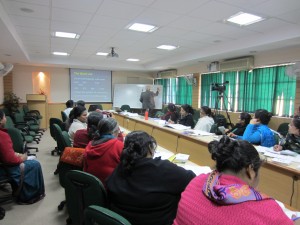LEM English Phonics Workshop

Enchiridion Education represents LEM Phonics in India. LEM is an educational methodology that transforms school communities by providing Professional Development for teachers so that they are personally and professionally successful. As a result their students love learning in their classrooms and their families join with them in their children’s sense of joy as they are given the ‘educational edge’ to personal freedom of choice in future career pathways.
Enchiridion India is linked with such world-class English medium education so that teachers can dynamically teach their students for life changing outcomes. Enchiridion is about ‘training the trainers’ with outstanding international success.

Richard Wilson of EES taking an LEM Phonics Workshop with many teachers from different schools throughout the Darjeeling Hills District in Mirik.
LEM Phonics has enabled English literacy and proficiencyto be dramatically increased across schools in China, South America, Africa where English is a second language and now in the linguistically rich nation of India. Rediscovering the excellence of Classical education foundations; Enchiridion education unlocks the world of linguistics with the grain of nature that is structured, systematic and comprehensive so the students know the ‘Whys’ and ‘Hows’ of learning, not just the slavish ‘does’ that may not make much sense! Enchiridion prepares students to love learning because such learning motivates with good sense and valid outcomes.
Literate for life
It’s time to restore the love of learning with the joy and satisfaction that comes with success in literacy.
Enchiridion India presents LEM Phonics as a unique programme of English literacy that was developed in Australia but derived from the best educational origins in Britain and the United States.
LEM Phonics is a comprehensive intensive phonics programme, training and equipping young people to live vital and vibrant lives enriching our communities.
Look at the benefits:
- Children can read and spell well by the end of the first year.
- Reading, writing and spelling learnt simultaneously.
- All learning styles are used, to suit all types of learning – kinesthetic, visual and aural.
- Materials are inexpensive.
- Courses to equip teachers in the method are conducted throughout India.
- LEM Phonics is an excellent remedial reading or ESL programme.
English: Chaos or Order?
For many years people have been telling us that English is a chaotic language because it has no regular structure or rules to govern the writing of words.

Demonstrating to teachers that even in high school classes LEM Phonics is very effective and can be taught in a large group. These schools belong to a group of 80 presbyterian schools in Mizorim, India.
The historic roots of the English language demonstrate that, far from being chaotic, English is a highly systematic and consistent language. Well-defined rules govern the use of phonograms (the written representations of sound), spelling patterns, and grammatical structure.
In recent decades literacy skills have been predominantly taught using the whole word method. The rich heritage of phonics that unlocks so many of the keys to our language was set aside — resulting in a deterioration in literacy skills and a limited understanding of the tools we subconsciously use to read and write.
What is LEM Phonics?
LEM Phonics is a complete, definitive literacy programme achieving excellent results in schools across the nation and in many nations across the world.
LEM Phonics is simple to teach and easy to understand. This comprehensive English programme takes the student through the foundational years of literacy education to develop fluent reading, accurate spelling, intelligent comprehension and good grammar.

LEM Phonics Seminar for the Ullans School in Kathmandu. This is a very progressive school seeking to establish self motivated students rather than textbook driven students. It was very stimulating working with these members of staff.
LEM Phonics:
- is a comprehensive literacy; programme that teaches speaking, listening, reading, spelling, writing and handwriting skills using a multisensory methodology;
- is consistent with thorough, current scientific research into literacy development;
- can be used with all age groups from pre-school to adult learners;
- promotes phonemic awareness, allowing learners to grasp the connections between speaking, reading, spelling and writing;
- places emphasis on both the phonemes (sounds) and phonograms (written representations of sounds) of the English language;
- teaches all sounds of each phonogram from the beginning (e.g. ‘a’ has five sounds);
- teaches spelling rules (‘which phonogram should I use to say this sound?’) and reading rules (‘which sound does that phonogram make?’);
- uses a diagnostic approach to reading, spelling and writing, teaching both teachers and learners how to self-diagnose their work;
- builds vocabulary using a methodology that strengthens logical and analytical thinking skills;
- regularly reinforces and reviews the concepts taught to help ensure learners’ success;
- emphasises accuracy and fluency with comprehension as the ultimate goal of reading;
- offers a wide range of resource materials for both learners and teachers and
- offers an adapted programme for ESL and remedial students.
How Does it Work?

LEM Phonics gives learners the skills to confidently break a word into its parts and either decode them (for reading) or encode them (for Spelling). Rather than learning thousands of unique words, they learn the component parts of these words and the rules that govern them. We have consistently found that when children are taught using the LEM Phonics method teachers are delighted at the significant improvement in all aspects of literacy.
The Phonograms

Each sound in the English language can represented by a single letter (b, t) or multiple letters (ee, igh). These written units of sound are called phonograms. The 42 sounds of the English language are represented by 75 phonograms. Memorising the phonograms and their sounds is the first skill students learn.
Although ‘d’, ‘o’, ‘g’ sounds like dog, ‘f’, ‘i’, ‘s’, ‘h’ does not sound like fish when sounded as individual letters. Children learn the combined letter graphemes (multiple phonograms) as well as learning the different sounds the phonograms can represent (for example, c can sound like ‘k’ in cat or ‘s’ in city).
The Rules
In order to read a word, one needs to answer the question ‘Which sound is that particular phonogram saying?’ Does the c in city sound like ‘k’ or ‘s’?
In order to spell a word, the question becomes ‘Which phonogram should I use to say that particular sound?’ Should the ‘ow’ sound in down be spelled with ow (down) or ou (doun)?
One of the keys to the success of LEM Phonics is the set of rules, which answer these two questions for the phonograms and sounds. Our examples above can be solved by knowing these rules:
- c says ‘s’ when followed by e, i or y
- we use the phonogram ow to say the sound ‘ow’ before n alone.
LEM Phonics also uses rules for prefixes and suffixes.
Through listening to the sounds of the phonograms in each word and understanding and applying the rules learners are soon reading comprehensively, building spelling skills and developing an understanding of grammar.
LEM Phonics Methodology

We learn best:
- When we involve the whole person (mental, physical and spiritual)
- Through the satisfaction of genuine effort
- Utilising as many of our five senses as possible
- When there is meaning and purpose
- When new concepts are built upon what is already known
- through being challenged to think analytically and logically
- within an orderly framework
- when we are accountable for our work
- when our learning is consolidated by review and testing
- through being challenged to think analytically and logically
Are rules unnecessary? Not Creative?
Here’s a quote from a teacher who initially rejected LEM Phonics because of the rules:
‘Having trained as a teacher in the1980s the phrase ‘sets of rules’ had a bad effect on me. I found, however, my daughter needed ‘footpegs’. As we began using the LEM programme I could see we had the answers I was looking for.’




